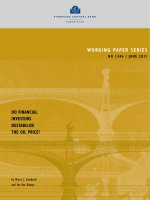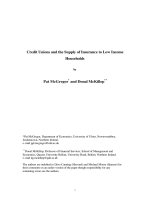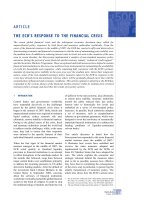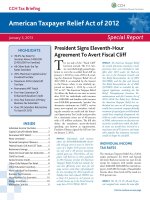Individual investors to drive stock market_1 pdf
Bạn đang xem bản rút gọn của tài liệu. Xem và tải ngay bản đầy đủ của tài liệu tại đây (284.68 KB, 18 trang )
1857 A major financial panic hits Wall Street with the collapse of
the Ohio Insurance & Trust Company.
1861 With the outbreak of the Civil War in April, the NYS&EB
suspends trading in Southern state bonds.
1863 The board adopts the name New York Stock Exchange.
1865 The NYSE moves to new headquarters on Broad Street. Wall
and Broad Streets becomes a hub of securities trading. In that
same year, the exchange closes for more than a week following
the assassination of President Lincoln.
1866 The completion of the trans-Atlantic cable allows traders in
New York and London securities markets to communicate in
hours, not weeks.
1867 The stock ticker, invented by Edward A. Calahan, is
introduced. The ticker provides investors outside of New
York with current prices on the exchange.
1869 Goldman founded by Marcus Goldman. Samuel Sachs, his
son-in-law, becomes senior partner in 1904 leading to the
firm’s name change to Goldman Sachs.
1870 Jay Gould and his associates fail to corner the gold market
through speculative manipulation. The result is a dramatic
fall in gold prices and hundreds of business failures. A sig-
nificant break occurs in the stock market on September 24,
referred to as Black Friday.
1871 NYSE adopts the practice of continuous trading, thus
replacing the call market approach used since the early
1800s. Brokers dealing in certain stocks must remain in one
location on the trading floor thus giving rise to specialists.
1873 The Philadelphia banking firm of Jay Cooke & Company
fails due to huge losses in speculative trading in railroad
stocks. The NYSE closes for ten days due to the ensuing
financial panic.
1878 The first telephone is installed on the trading floor of the
NYSE.
Stock Exchange Ordinance enacted and Tokyo Stock
Exchange Co., Ltd. is established.
xviii Chronology
1886 Trading on the NYSE hits 1 million shares for the first time
on December 15.
1893 Panic of 1893, one of the most severe economic downturns
in U.S. economic history, causes widespread financial distress.
Stock market losses are large.
1896 The Wall Street Journal publishes the Dow Jones Industrial
Average (DJIA) for the first time. The index is comprised of
twelve stocks and has an initial value of 40.74.
1903 On April 22 the NYSE moves to its present site. The trading
floor has been in use since that time.
1907 Initiated by the financial troubles of the Knickerbocker
Trust, a leading New York banking firm, stock prices tumble.
The panic of 1907 ensues. Financier J. P. Morgan mobilizes a
bailout of banks that stems the decline in stock prices.
1910 Arthur, Herbert, and Percy Salomon form Salomon Bros. &
Company.
1913 President Wilson signs the Federal Reserve Act in December,
creating the Federal Reserve System.
1914 Due to events in World War I, rapidly declining share prices
prompts the NYSE to close on July 31. The exchange does
not open until mid-December, the longest period of time
that the exchange has not operated.
1915 Beginning in 1915 share market prices are quoted in dollars,
not as a percent of their par value.
Charles E. Merrill & Co. becomes Merrill, Lynch & Co.
1920 The NYSE creates the Stock Clearing Corporation, a cen-
tralized system that speeds up the delivery and clearing of sec-
urities among exchange members, banks, and trust companies.
1924 Massachusetts Investors Trust is founded, the first open-end
mutual fund in the United States.
1927 First American Depository Receipt (ADR) is created by J. P.
Morgan. The purpose is to facilitate trading by U.S. investors
in the British firm Selfridge.
1929 Share prices fall sharply on Black Thursday, October 24,
1929. Over 13 million shares traded that day, a record up to
Chronology xix
that time. On October 29, Black Tuesday, a record 16 million
shares are traded and the DJIA falls more than 11 percent.
The DJIA hit bottom in July 1932, nearly 90 percent below
its September 1929 peak.
1929–1933 The Great Depression.
1933 The NYSE closes on March 4 when President Franklin
Roosevelt declares a bank holiday. The holiday, a time when
banks would cease operations, often marks the end of the
Great Depression.
Congress passes the Banking Act of 1933. The act separates
commercial and investment banking, and creates the Federal
Deposit Insurance Corporation (FDIC).
Congress passes the Securities Act of 1933. Called the ‘‘truth
in securities’’ act, it requires companies to provide investors
with more information about company business and finan-
cial information.
1934 Congress passes the Securities Exchange Act of 1934. The act
requires increased disclosure by firms to investors to thwart
speculative trading and fraud that occurred prior to the 1929
market crash. The Securities and Exchange Commission
(SEC) is created as part of the Act.
1935 Harold Stanley and Henry S. Morgan, together with other
employees from J. P. Morgan & Co. and Drexel & Co., form
the investment banking firm of Morgan Stanley & Co. In
1941 the firm joins the NYSE and enters the brokerage
business.
1938 William McChesney Martin, Jr. becomes the first full-time,
salaried president of the NYSE. Martin, who later would
serve as chairman of the Federal Reserve Board of Governors,
reorganizes the exchange.
Charles D. Barney & Co. merges with Edward B. Smith &
Co. to form Smith Barney & Co.
1940 Investment Advisors Act is passed. It requires financial
advisors to register with the SEC.
1941 The constitution of the NYSE is revised to centralize authority
over the exchange’s operations in the office of the president.
xx Chronology
1943 Women are allowed to work on the trading floor for the first
time in NYSE history.
1945 The NYSE closes on August 15 and 16 to celebrate V-J Day,
the end of World War II.
Frankfurt Exchange reopens in September after being closed
for six months.
1949 In April the Tokyo Stock Exchange reopens in its modern
form.
1950 The Nikkei 225 is first reported by the Tokyo Stock
Exchange.
1953 Although it began as an outdoor market on Broad Street in
the 1800s, it is not until 1953 that the American Stock
Exchange (AMEX) is so named.
1954 The NYSE launches its Monthly Investment Plan (MIP)
allowing individuals to make a minimum monthly invest-
ment of only $40 through special accounts with NYSE
member firms.
1955 Chase Manhattan Bank formed when Bank of the Manhattan
Company (est. 1799) purchases Chase National Bank (est.
1877).
1957 S&P 500 introduced by Standard and Poor’s. The original
index includes 233 firms, expanded to 500 in 1957.
1958 Legislation creating the S Corporation passed and signed into
law.
1961 Trading on the NYSE exceeds 4 million shares.
1962 Kmart, Target, and Wal-Mart begin operations. Wal-Mart
would grow to become the nation’s largest retailer.
1963 The assassination of President John Kennedy prompts the
NYSE to close early to avoid panic selling.
1964 The 900 ticker replaces the black box ticker, doubling the
speed at which price information flows.
1966 The NYSE Composite Index is established, including all
listed common stocks. The initial value of the index is fifty.
Also, the first electronic ticker displays are introduced.
Chronology xxi
1967 Muriel Siebert becomes the first woman member of the
NYSE.
1968 Intel is founded by Gordon E. Moore and Robert Noyce.
Intel grows to become the world’s largest semiconductor
company.
1969 Tokyo Stock Price Index (TOPIX) is introduced.
The Hang Seng Index is introduced in the Hong Kong Stock
Exchange.
1970 Joseph L. Searles III becomes the NYSE’s first black member.
Securities Investors Protection Act is passed. The act creates
the Securities Protection Corporation (SIPC), an insurance
company to stock investors. The SIPC protects investors
from losses due to broker malfeasance and fraud.
1971 The NYSE becomes the New York Stock Exchange, Inc.
following incorporation as a not-for-profit corporation in
February.
The National Association of Securities Dealers Automated
Quotations (NASDAQ) is formed. It is the world’s first
totally electronic stock exchange in the world.
1972 The DJIA passes through the 1,000 level on November 14,
1972, reaching 1,003.16 at the close of trading.
1973 The Depository Trust Company is established to serve as a
central depository for securities certificates based on
electronically recording stock ownership transfers.
Drexel & Co. merges with Burnham & Co. to form Drexel
Burnham, one of the most successful investment banks in the
1970s and 1980s. The company files for bankruptcy in 1990
after the scandals rock the firm and lead to the indictments of
David Levine and Michael Milken.
Chicago Board Options Exchange (CBOE) opens, the
world’s first stock options exchange.
First female members admitted to the London Stock
Exchange.
1975 Charles Schwab opens the discount brokerage firm. Charles
Schwab is acquired by Bank of America in 1983.
xxii Chronology
Microsoft founded in Albuquerque, NM, by Bill Gates and
Paul Allen.
1976 The Designated Order Turnaround (DOT) system is in-
troduced to facilitate the trading of smaller orders. In May
specialists begin trading in lots of less than 100 shares, the so-
called odd lot trades.
The first retail fund index is created: First Index Investment
Trust (now called Vanguard 500 Index).
Apple Computer is formed in April by creators of the Apple I
personal computer, Steve Jobs and Steve Wozniak.
1977 Chicago Board of Trade (CBOT) offers first U.S. Treasury
Bond futures contract.
The TSE 300 Composite Index is introduced by the Toronto
Stock Exchange. This same year, the Toronto exchange
introduces its Computer Assisted Trading System (CATS).
1978 The Integrated Trading System (ITS) begins operation. The
ITS electronically links the NYSE and other exchanges to
permit fuller access by brokers to security prices nationwide.
1979 The New York Futures Exchange (NYFE) is formed by the
NYSE.
1981 Congress creates the Individual Retirement Account (IRA).
1982 Shares traded on the NYSE exceed 100 million for the first
time.
1984 To handle increased trading pressure, the Super Dot 250 is
inaugurated. The Super Dot 250 links member firms to
specialist posts and represents yet another advance in elec-
tronic trading.
FTSE 100, representing the 100 largest firms traded on the
London Stock Exchange, is introduced. FTSE is a mnemonic
for Financial Times Stock Exchange.
1985 Trading hours are changed to their current times of 9:30
A.M.
to 4:00 P.M., Eastern. In March Ronald Reagan becomes the
first sitting U.S. president to visit the NYSE trading floor.
1986 Deregulation of the London stock trading begins, known as
the Big Bang.
Chronology xxiii
1987 The DJIA experiences its largest one-day percentage drop
on October 19. The DJIA fell 508 points, or 22.61 percent
on that day with trading volume surging to a record 604
million shares. This trading volume was exceeded the very
next day with over 608 million shares traded.
President Reagan creates the Presidential Task Force on
Market Mechanisms, headed by Treasury Secretary Brady.
The task force proposes ‘‘circuit breakers’’ to halt trading
when price declines become too large.
1988 To prevent future occurrences of wide price swings as in
October 1987, the SEC approves circuit breakers. Circuit
breakers halt trading when share prices become too volatile.
1989 Michael Milken, known as the ‘‘king of junk bonds,’’ is
indicted on ninety-eight counts of racketeering and fraud. He
eventually serves twenty-two months in jail (March 1991
through January 1993) and pays a fine in the millions.
1991 The DJIA closes above 3,000 for the first time on April 17.
Off-hours trading sessions are begun by the NYSE.
1992 The NYSE celebrates its bicentennial on May 17. Former
president Ronald Reagan and former Soviet president
Mikhail Gorbachev tour the trading floor.
1993 The Integrated Technology Plan is introduced to improve
the capacity and efficiency of trading floor operations. The
NYSE now trades over 1 billion shares daily.
1994 The uniform shareholders’ voting rights policy is adopted by
the NYSE, the AMEX, and the National Associations of
Securities Dealers.
1995 Improvements occur in the use of cellular technology, flat
screen monitors, fiber optics, and hand-held terminals. The
DJIA passes through 5,000, closing at 5,023.55 on No-
vember 21.
Barrings Bank, one of the oldest merchant banks in England,
collapses due to speculative trading losses by one of its
traders, Nick Leeson.
eBay is founded in San Jose, CA, by Pierre Omidyar as
Auctionweb. The name is changed in 1997 and it goes public
in September 1998.
xxiv Chronology
1996 Real-time quotes are listed on CNBC and CNN-FN. Prior
to this all quotes were delayed twenty minutes. This year saw
a continuation of a trend: the listing of non-U.S. companies.
In July the number reached 290 companies with a volume of
over 681 million shares traded.
The Toronto Stock Exchange introduces decimal trading.
Alan Greenspan, the chairman of the Board of Governors of
the Federal Reserve System, coins the phrase ‘‘irrational
exuberance’’ in a speech to the American Enterprise Institute
in Washington, D.C.
1997 The Wireless Data System is introduced to allow brokers to
receive orders and execute sales from any location on the
floor.
Asian Crisis hits as speculative trading drives down the ex-
change value of the Thai baht. The financial crisis spreads to
other major Asian currencies and financial markets.
On October 27 the DJIA drops 514 points triggering the
circuit breaker rule for the first time. Trading in stocks is
halted at 3:30
P.M. The following day trading volume exceeds
1.2 billion shares as the DJIA rebounds 337.17 points.
The Toronto Exchange moves to electronic, floorless trading,
one of the world’s first exchanges to do so.
1998 In April, volatility in the market leads the NYSE to invoke
new circuit breaker rules when the DJIA declined 10, 20, and
30 percent.
Russian financial system collapses in August following de-
fault by Russian government. DJIA drops 512 points (6.4
percent) on August 31.
Long-Term Capital Management (LTCM), a major hedge
firm, narrowly escapes collapse due to events surrounding
financial problems in Russia. LTCM is bailed out by a con-
sortium of banks through a deal brokered by the New York
Federal Reserve.
Google incorporates.
The AMEX and NASDAQ merge.
Chronology xxv
1999 March 19 marks the first time the DJIA closes above 10,000.
Since 1991 the DJIA has increased more than three-fold.
AOL acquires Time Warner in one of the largest takeovers to
date.
Barbara G. Stymiest is appointed as the president and CEO
of the Toronto Stock Exchange. She becomes the first woman
to head a major North American stock exchange.
2000 The feared ‘‘millennium bug’’ fails to materialize.
The DJIA reaches its all-time high of 11,722.98 on January
14. On March 16 the DJIA experiences the largest single-day
increase of 499.19 points. A month later, on April 14, the
DJIA experiences its single-largest one-day point decline,
falling 617.78 points. The bull market of the 1990s is over.
J. P. Morgan Chase & Co. formed when Chemical Bank (est.
1823) and J. P. Morgan & Co. (est. 1895) merge.
Stock Exchange of Hong Kong and Hong Kong Securities
Clearing Co. merge to form Hong Kong Exchanges &
Clearing, Ltd., better known as HEKx.
The stock exchanges of Amsterdam, Brussels, and Paris
merge to form Euronext N.V., the first cross-border exchange
in Europe.
2001 Volume of trading on the NYSE exceeded 2 billion shares for
the first time on January 4.
Decimal pricing of all NYSE stocks is fully implemented on
January 29.
The Enron Corporation files for bankruptcy.
On September 11, terrorist attacks destroy the World Trade
Center. The NYSE closes for four days—its longest closure
since 1933—and reopens on September 17 with a record
trading volume of 2.37 billion shares.
2002 The Sarbanes-Oxley Act, which aims to improve the accuracy
and reliability of firm data through increased corporate
disclosures, goes into effect.
Chicago Mercantile Exchange (CME) becomes the first pub-
licly traded U.S. financial exchange when its shares are traded
on the NYSE.
xxvi Chronology
Arthur Andersen, LLP, the Chicago-based accounting firm, is
convicted of obstruction of justice in its role as auditor of
Enron.
2003 As a fallout of recent corporate scandals, the SEC approves
the NYSE’s new corporate governance standards for listed
companies. This requires boards of NYSE-listed companies
to have a majority of independent directors, and requires that
nomination, compensation, and audit committee consist
solely of independent directors.
2004 J. P. Morgan Chase & Co. merges with Bank One to form
one of the nation’s largest financial services companies.
Google goes public on August 19, 2004.
2005 The NYSE and ArcaEx announce on April 20 that they have
entered a definitive merger agreement leading to the com-
bined entity, NYSE Group, Inc., becoming a publicly-held
company. June 24 sees the NYSE handle its largest single
volume day: 3,115,805,723 shares.
2006 In March the NYSE Group, Inc., a for-profit, publicly-
owned company, is formed out of the merger of the NYSE
and Archipelago Holdings, Inc. The merger is the largest-ever
among securities exchanges.
Chronology xxvii
One
Introduction
Stocks and the markets in which they are traded are important parts of our
personal finances and national economies. Today more people than ever own
stocks directly, or indirectly through mutual funds, 401k programs, or pen-
sion plans. In the bigger picture, stock markets offer individuals and in-
stitutions a means to build wealth or reduce risk of financial loss. The
increasingly complex web of financial transactions that characterize today’s
economy often puts stock markets at the center of economic booms and busts.
More and more, everyone looks to ‘‘the market’’ for a signal on where the
economy is headed.
Stocks represent a retirement nest egg for households and a source of
financing for businesses. Without the availability of stocks and the develop-
ment of financial markets, there would not have been the substantial growth
in new businesses created or the growth in our economy. It is, therefore, im-
portant for everyone to have a good understanding of stocks and stock
markets.
What is a stock? This may sound simple, but it is a useful question to get
the discussion rolling. Pick up a finance textbook and it will say that a stock is
a financial asset to its owner. It also will say that a stock is a claim against the
firm that issued it. Both are correct. When a company issues stock, it acquires
funds from those who initially purchase it. Firms sell stock to expand their
operations, using the funds to, say, build a new factory or launch a new product
line. Once the stock is purchased, however, the firm actually gets no addi-
tional funds when the stock is traded over and over. That is, when someone
calls a broker and buys a share of Google, the money spent is simply trans-
ferred to someone who has decided to sell a share of Google. Once stocks are
publicly traded, the issuing firm receives no additional funds.
Even though the firm receives no additional funds from the public trading
of its stock, those outstanding shares are claims against the firm. Owning a
share of Google gives you some claim over their future profits, and some claim
over how the firm is run—shareholders can vote at Google’s annual meeting.
The former aspect of stock ownership is important because if the firm does
well, it is likely that others will want to buy the stock. Since at any one point in
time there are only so many shares of stock outstanding, increased demand for
a stock drives up its price. For instance, if more and more investors think
Google is likely to turn in higher profits, the increased demand for the stock
increases its price. For those who bought Google’s shares early in this process,
as the price increased they became better off: on paper their wealth increased.
It is useful to distinguish at this point the confusion between wealth and
income, especially as it relates to the stock market. Wealth refers to the
difference between the value of assets and liabilities at a point in time. For
example, suppose an individual has 100 shares of XYZ stock, currently priced
at $1. Suppose also that they owe $50 to the local bank on a car loan. If that is
all the financial assets they own and the loan is the only liability, their wealth
is $50, the value of assets (the stock) minus liabilities (the loan). The dis-
tinction is that ‘‘paper wealth’’ is not realized until the stock is sold.
Stocks are traded on a number of exchanges and electronic markets, al-
though trading is heading more and more to electronic trading. An exchange
usually is thought of as a physical location where traders meet face-to-face to
trade stocks. In such an open outcry market, traders announce prices at which
to buy stock, or prices at which they are willing to sell. When the two prices
are matched, a deal is done. One such market is the New York Stock Exchange
(NYSE). Watch any of the financial news networks’ wrap of stock market
activity, and often a reporter is found on the floor of the exchange, surrounded
by people scurrying around. Those people are engaged in trading stocks.
With the advancing technology of trading, the future of markets like the
NYSE is limited. Many stock trades today occur not on the floor of a NYSE-
type exchange but through an electronic connection between brokers and
dealers. This increased sophistication of trading allows information to flow
more rapidly and permits trades to be executed quickly. In the United States,
an example of such a market is the National Association of Securities Dealers
Automated Quotation System (NASDAQ). In the near future, the NYSE also
is moving to an electronic format that will reduce activity on its floor.
This brings up an important though sometimes confused point: Stock
indexes and stock exchanges or markets are two distinctly different things.
The Dow Jones Industrial Average (DJIA) is perhaps the most recognized of
the many stock indexes. The value of the DJIA is derived from changes in the
prices of the thirty stocks that comprise it. The rise or fall of the index on any
2 The Stock Market
given day reflects what is happening to the prices of its component stocks, like
Wal-Mart or Coca-Cola. The stocks in the DJIA are traded on an exchange,
such as the NYSE. There is no market or exchange called the DJIA or, think-
ing internationally, the FTSE-100. These are indexes that combine stocks
that reflect changes in investors’ buying and selling. A stock index is not a
physical or electronic exchange.
How many exchanges are there? In the United States there are three major
exchanges. The most recognizable is the NYSE. This exchange has one of the
longest histories in the country and is the one most people think of when
referring to ‘‘the stock market’’ today. (A brief history of the NYSE is found in
Chapter Two.) The NYSE holds a special place because of its history. The
NYSE also is where an average of over 1.6 billion shares of the companies
listed on the exchange is traded on a daily basis. The other market that gets
attention is the NASDAQ. Unlike the NYSE, the NASDAQ market is
electronic: there is no physical exchange. In fact it is the largest electronic
The fac¸ade of the New York Stock Exchange,
the iconic image of the stock market. Photo
courtesy of Corbis.
Introduction 3
securities market in the United States. In this market the stocks of over 3,100
firms are traded, firms that often are associated more with newer technologies.
NASDAQ is where companies such as Apple Computer, Inc., Microsoft, and
Intel are listed and traded. The other major market is the American Stock
Exchange (AMEX). With a history dating from the 1800s, this exchange
began literally on the curb outside the more established New York Exchange.
Taking the name American Stock Exchange in 1953, the AMEX remains
one of the major exchanges in the United States.
What about stock markets in other parts of the world? A brief history of
some of the major exchanges, such as stock markets in London, Germany,
and Hong Kong is presented in Chapter Seven. Suffice it to say that a simple
search reveals that there are almost 150 independent stock exchanges spread
across the globe. The list of exchanges literally runs from A to Z: from the
Abidjan Exchange to the Zimbabwe Stock Exchange. Indeed, a brief visit to
the Internet site www.finix.at indicates that there are links to 145 different
stock exchanges. Why so many? That too is a topic for discussion in Chapter
Seven. At this point, however, the quick answer is that stock markets rep-
resent an efficient way to reallocate financial capital in a country. Without a
functioning stock market, how do funds find their way to firms wishing to ex-
pand? How do individuals save for the future? The results of research into
these questions suggest that having a functioning stock market likely improves
a country’s chances for faster economic growth.
If there are so many exchanges, how many different stock indexes are
there? The answer is hundreds. In the United States alone there are over thirty
different stock indexes traded everyday. There is, for example, stocks in the
DJIA that was mentioned earlier. More correctly, that DJIA is an index of
thirty ‘‘industrial’’ stocks. Industrial is in quotes because the companies listed
in the DJIA often are not industrial companies in the traditional sense. Wal-
Mart, the nation’s largest retailer, would not be considered an industrial com-
pany, but it is in the DJIA. Looking at a listing of the DJIA companies over
time (available in the Appendix) reveals how the composition of the index has
changed.
Other U.S. indexes include the Down Jones 20 transportation company
index, the Dow Jones 15 utility company index, and the Dow Jones 65 com-
posite index, the latter being a broad-based compilation of companies across
several industries. There also are the often mentioned Standard & Poors 500
index and the NASDAQ composite index. Other indexes followed by investors
include the various Russell indexes (1,000, 2,000, and 3,000 firms), the in-
dexes made up of companies in the AMEX, and even some as narrow as the
Philadelphia Semiconductor index. Popular foreign indexes include the
London Exchange’s Financial Times Stock Exchange 100 Index (FTSE-100)
4 The Stock Market
and the Hang Seng Index traded on the Hong Kong Stock Exchange, among
others.
Some often ask why there are so many indexes. The simple reason is that
each index offers investors a different package of companies that best suits their
investment needs. One index may be ‘‘riskier’’ (experience more price vola-
tility) than another and attract one set of investors. Others may prefer to invest
in an index known more for long-term appreciation. There also are indexes
that allow residents in one country to invest in another country’s stocks. The
array of stocks and stock indexes from which to choose allows an investor to
mold their stock portfolio to suit their needs. If investors think the future
looks bright for companies in the technology sector, they could buy indi-
vidual stocks of such companies or invest in a technology-based index that
includes several of these firms. The capability of investing in an index not
only increases coverage of the businesses in which to invest—from utilities to
transportation to banking—but it also diversifies risk. Investing in an index
lessens the risk that invested funds will vanish as they might if invested in only
one firm. After all, owning stock in a firm does not guarantee that those funds
will be there in the future: firms sometimes do go bankrupt. The disappear-
ance of firms following the crash in 1929 and the more recent post–2000
decline in the market is testimony to the fact that investing in stock is a risky
venture. Buying an index helps spread that risk out.
If investing is risky, why do it? This question is like asking why people
climb dangerous mountains or bungee-jump off of bridges. Such activity gives
them a thrill, a rush, an exhilaration that outweighs the potential calamity. For
investors, however, buying into the stock market—a risk-taking activity—is
done with the expectation of financial gain. The expectation is that if a stock
is bought today, its price will be higher some time in the future when it can be
sold and the capital gain realized.
Most individuals working today participate in some type of retirement
plan, either through their employer or in a self-directed plan. The reason
is that they wish greater financial security in their future. Households in the
United States increasingly have turned to the stock market as a source of
financial gain. According to Equity Ownership in America, 2005 published by
the Investment Company Institute and the Securities Industry Association
(2005), in 2005 nearly 57 million households in the United States report
owning stocks. This number represents about one-half of all households.
What makes this level of participation even more astounding is that in 1983
only about 16 percent of households held stock. One explanation for this
surge in equity ownership is increased use of the stock market as a vehicle for
retirement saving, whether indirectly through employer retirement plans or
in direct ownership.
Introduction 5
A related reason why people invest in stocks is evidenced in the behavior of
the market itself. Over the past twenty-five years the return from investing in
the stock market has been quite remarkable. Of course, timing is a critical
factor in making this statement, as the adjoining figure suggests.
Figure 1.1 shows the daily close of the DJIA for the period since 1950. The
top panel shows the actual daily close for the index. Because it rose so dra-
matically in the 1990s, the increases from 1950 to the mid-1980s are dwarfed
FIGURE 1.1
Dow Jones Industrial Average: Close, 1950–2006
Source: Adapted from www.economagic.com.
6 The Stock Market
and appear inconsequential. To adjust for this scaling problem, the bottom
panel plots the index using a proportional (logarithmic) scale. This shows the
increases in a relative format, indicating that even though the 1990s still stand
out, there were some substantial gains—and losses—in the past half-century.
Figure 1.1 shows that the index has been subject to ups and downs, some
quite severe. Even if one knew that the market would take a nosedive in 1987,
was it wise to invest in stocks back in 1980? The answer is yes, of course. Look
at the figure: The level of the DJIA is much higher today, even after the 1987
decline than it was twenty-five years ago. For those investors who bailed out
following the 1987 crash—a monumental decline in stock prices at the time,
but a small blip in the figure—they missed out on one of the largest and
longest bull markets in U.S. history.
But what if someone invested in 1965 with the idea that they had ten years
until retirement? The figure also shows that stock prices may not always move
upward as smartly as they did since the 1980s. Indeed, the DJIA was about
the same value in 1980 as it was in 1965. This means that stock-derived
wealth would not have improved very much, if at all. As they say, timing is
everything.
The very fact that stocks do not always increase in value means that it is
very important for potential investors, policymakers, politicians, and average
citizens to better understand what the stock market is and how it functions.
In the late 1990s, as in the late 1920s, many thought that the stock market
was a sure-fire money machine: anyone who invested today would be rich in
the future. For some that expectation became a reality. For others, especially
those who got into the market in October 1929 or February 2000, they got a
different lesson in investing. These two extremes suggest the need to better
understand the market for what it is and what it is not. That is the purpose of
this book.
Introduction 7









